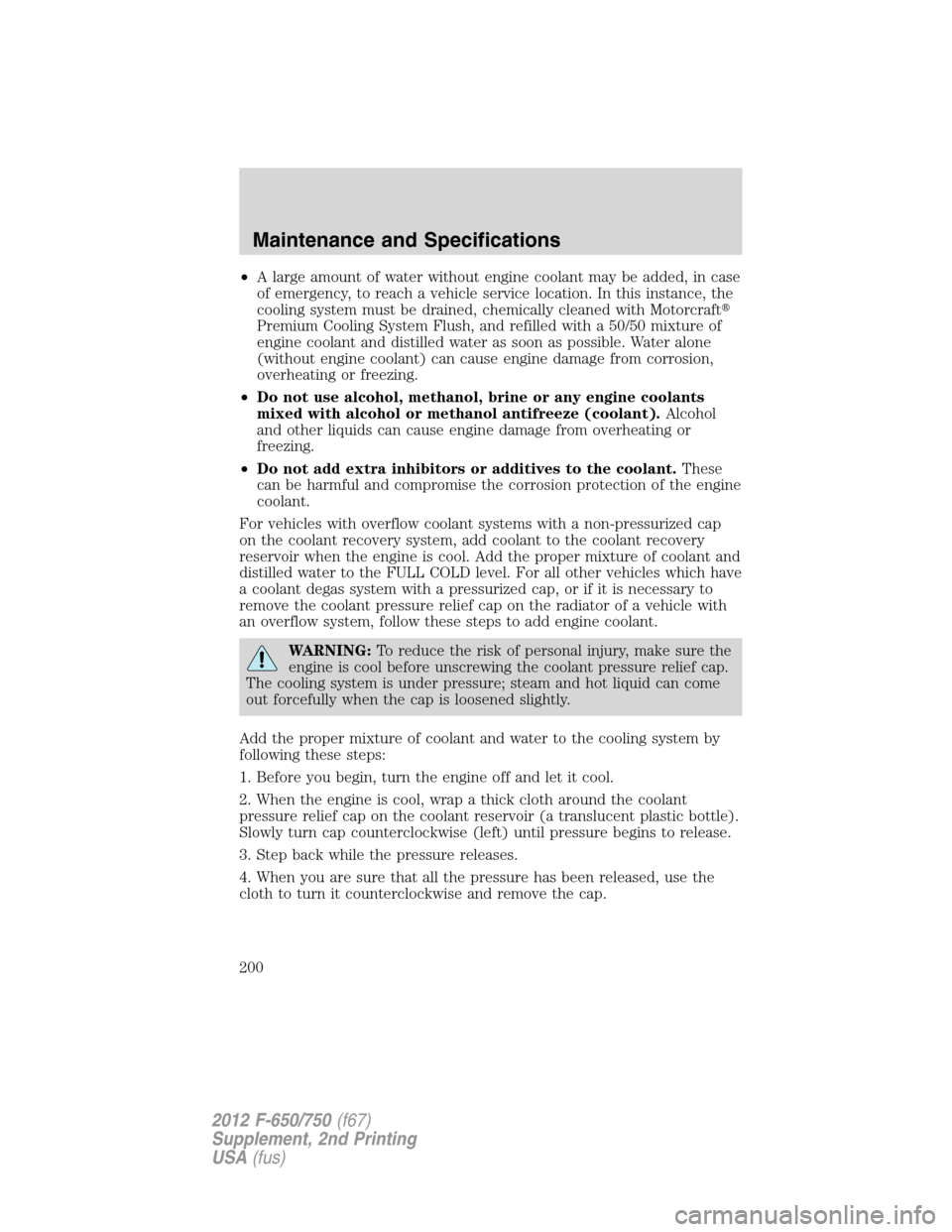Page 200 of 306

•A large amount of water without engine coolant may be added, in case
of emergency, to reach a vehicle service location. In this instance, the
cooling system must be drained, chemically cleaned with Motorcraft�
Premium Cooling System Flush, and refilled with a 50/50 mixture of
engine coolant and distilled water as soon as possible. Water alone
(without engine coolant) can cause engine damage from corrosion,
overheating or freezing.
•Do not use alcohol, methanol, brine or any engine coolants
mixed with alcohol or methanol antifreeze (coolant).Alcohol
and other liquids can cause engine damage from overheating or
freezing.
•Do not add extra inhibitors or additives to the coolant.These
can be harmful and compromise the corrosion protection of the engine
coolant.
For vehicles with overflow coolant systems with a non-pressurized cap
on the coolant recovery system, add coolant to the coolant recovery
reservoir when the engine is cool. Add the proper mixture of coolant and
distilled water to the FULL COLD level. For all other vehicles which have
a coolant degas system with a pressurized cap, or if it is necessary to
remove the coolant pressure relief cap on the radiator of a vehicle with
an overflow system, follow these steps to add engine coolant.
WARNING:To reduce the risk of personal injury, make sure the
engine is cool before unscrewing the coolant pressure relief cap.
The cooling system is under pressure; steam and hot liquid can come
out forcefully when the cap is loosened slightly.
Add the proper mixture of coolant and water to the cooling system by
following these steps:
1. Before you begin, turn the engine off and let it cool.
2. When the engine is cool, wrap a thick cloth around the coolant
pressure relief cap on the coolant reservoir (a translucent plastic bottle).
Slowly turn cap counterclockwise (left) until pressure begins to release.
3. Step back while the pressure releases.
4. When you are sure that all the pressure has been released, use the
cloth to turn it counterclockwise and remove the cap.
Maintenance and Specifications
200
2012 F-650/750(f67)
Supplement, 2nd Printing
USA(fus)
Page 201 of 306

5. Fill the coolant reservoir slowly with the proper coolant mixture, to
within the FULL COLD level, or within the COLD FILL or MIN / MAX
range as listed on the engine coolant reservoir (depending upon
application). If you removed the radiator cap in an overflow system, fill
the radiator until the coolant is visible and radiator is almost full.
6. Replace the cap. Turn until tightly installed. Cap must be tightly
installed to prevent coolant loss.
After any coolant has been added, check the coolant concentration (refer
toChecking engine coolant). If the concentration is not 50/50, drain
some coolant and adjust the concentration. It may take several drains
and additions to obtain a 50/50 coolant concentration.
Whenever coolant has been added, the coolant level in the coolant
reservoir should be checked the next few times you drive the vehicle. If
necessary, add enough 50/50 concentration of engine coolant and
distilled water to bring the liquid level to the proper level.
If you have to add more than 1.0 quart (1.0 liter) of engine coolant per
month, have your authorized dealer check the engine cooling system.
Your cooling system may have a leak. Operating an engine with a low
level of coolant can result in engine overheating and possible engine
damage.
Recycled engine coolant
Ford Motor Company does NOT recommend the use of recycled engine
coolant since a Ford-approved recycling process is not yet available.
Used engine coolant should be disposed of in an appropriate
manner. Follow your community’s regulations and standards for recycling
and disposing of automotive fluids.
Coolant refill capacity
To find out how much fluid your vehicle’s cooling system can hold, refer
toMaintenance product specifications and capacitiesin this chapter.
If your vehicle is equipped with a diesel engine,refer to your
operator’s manual.
Fill your engine coolant reservoir as outlined previously in theAdding
engine coolantsection.
Maintenance and Specifications
201
2012 F-650/750(f67)
Supplement, 2nd Printing
USA(fus)
Page 269 of 306

Observation Maintenance operation
Excessive engine compartment
noiseInspect the engine air induction
system (including air ducts and air
filter) for loose, damaged or
missing components
Poor steering; wandering;
excessive tire wearCheck front end alignment, inspect
the tires and tire pressure
(3)
Vibration or abnormal tire wear
indicating imbalanceBalance the wheels and the tires
Hard shifting or excessive
vibrationCheck the transmission and engine
mountings
(2)
High effort to shift; noisy
transmissionCheck and adjust transmission
controls(2)
Insufficient full-throttle power or
backfiringCheck fuel pump pressure
Radiator cap does not hold
pressureClean the cap seal and cap surface
on the radiator
Electrical power supply has
diminishedCheck the battery terminals for
corrosion
Cleaning the wiper blades with a
clean cloth and mild detergent and
washing with a cleaner does not
restore a clean wipeReplace wiper blades
Noisy or difficult to operate Lubricate body lock cylinders
Headlamp beams in wrong position
when vehicle operating loadedCheck headlamp alignment
Windshield washers do not spray
when operatedCheck windshield washer fluid
level; add fluid if required
1During maintenance and repair, protect the fuel tube and the hose
assemblies, power steering lines, and brake lines from external heat,
acids and abrasions that could damage them.
2Check for (free) linkage action and ensure that (return) spring force
is adequate to maintain pedal free play.
3Adjust, repair or replace as required with the same or equivalent
parts.
Scheduled Maintenance Guide
269
2012 F-650/750(f67)
Supplement, 2nd Printing
USA(fus)